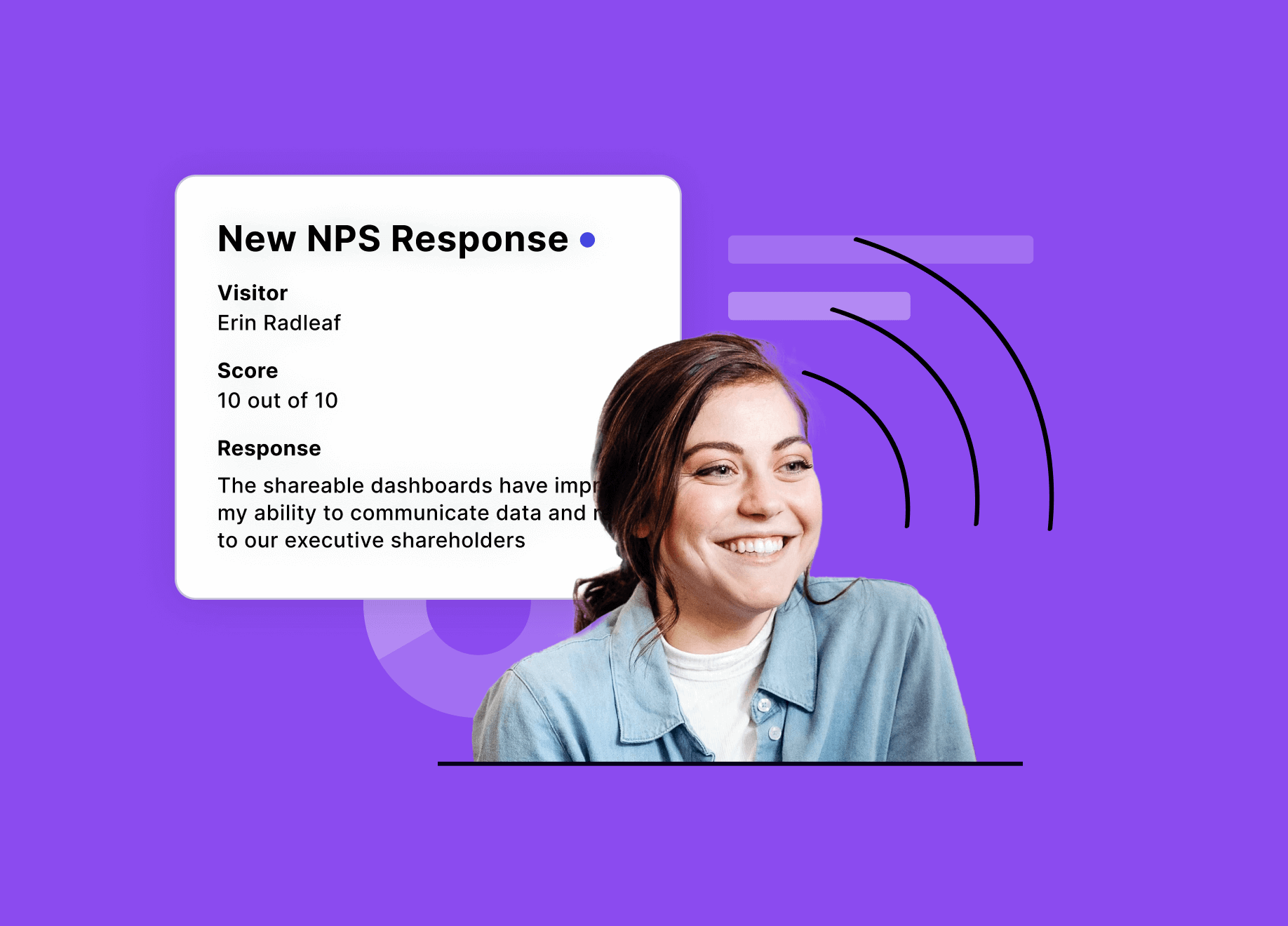
A COMPREHENSIVE GUIDE FOR PRODUCT MARKEERS
Voice of the Customer
A process or program used by a business to collect and take action on customer feedback.
Last updated: May 31, 2024
Dive deeper
Table of Contents
What is Voice of the Customer (VoC)?
Voice of the Customer (VoC) is a process or program a business uses to collect and take action on customer feedback. VoC data focuses on customers’ experiences to understand their needs and expectations to improve or enhance the product.
The Voice of the Customer (VoC) is a critical process or program that empowers businesses to gather and act on valuable customer feedback. By focusing on customer experiences (CX), VoC programs help product managers understand customer needs and expectations, ultimately leading to product enhancements and improvements. VoC plays a crucial role in assisting companies to achieve several key objectives:
- Understand the why behind their customers’ feedback, giving context to their opinions.
- Identify what customers need and want and any pain points they encounter using the product.
- Effectively synthesize feedback and distribute it across different departments within the organization, ensuring everyone is informed by the customer’s voice.
Why is Voice of the Customer important?
Studies show that 80% of software products are rarely or never used. This equated to a huge financial waste for product-led organizations. So, understanding (and correcting) the reasons for poor product adoption is critical for any product-led organization.
Collecting customer feedback is the most reliable way to understand where a product is performing well and where there are gaps stalling growth. All too often, however, customer feedback gets lost in a black hole, amassed but not synthesized. Everyone in your organization may completely agree with the proposition that collecting feedback is incredibly important. But after the initial thrill of gathering responses from disparate polls, surveys, reviews, and interviews, the work of translating those responses into actionable insights (and putting those insights to work) can fall flat.
A well-designed Voice of the Customer (VoC) program can come to the rescue.
A robust VoC program is essential for understanding why software products fail to gain traction. The real way to “reap the rewards of customer feedback” is to invest in “an effective and complete system to measure the experience of the customer journey,” according to McKinsey analysts.
VoC is a way to operationalize what your customers say. Whether it’s feedback collected in the product, on sales calls, or through support channels, VoC is the system that companies use to distribute the feedback to all internal stakeholders, especially those tasked with improving the usability and user experience (UX): product management.
What are the advantages of a strong Voice of the Customer program?
A VoC program helps you go beyond the what of user behavioral data to understand the why. Capturing feedback directly from the people who use your products and services every day —through surveys, interviews, and other feedback mechanisms—provides valuable insight into their experiences, which would be hard for you to evaluate objectively as the expert of your own product.
VoC helps you build a better product experience and CX. Customer feedback is often the genesis of new features, enhancements, or functionality—and a valuable input for your product roadmap. It also saves your team time and resources. You won’t be left guessing what to build next or wondering which features will best meet your customers’ needs because you’ll already know what your customers are looking for.
Having a VoC process in place also signals that you value your customers’ thoughts and consider their needs when building your product roadmap. This two-way engagement ultimately increases customer loyalty and improves their perceptions of your brand.
Finally, VoC is a powerful tool for driving organizational change. In the saturated world of Software-as-a-Service (SaaS) companies, where it’s easy for customers to switch vendors, experience is more important than ever. A VoC program is a great way to easily socialize customer feedback and encourage people throughout your organization to see their role in shaping the CX. A well-honed VoC program also helps operationalize customer sentiment by creating accountability mechanisms and establishing clear follow-through processes so nothing gets lost in the black hole of feedback.
How can a VoC program benefit product managers and development?
With a VoC program, product-led organizations, product managers, and their teams realize numerous benefits to their operations. VoC programs, data, insights, and metrics can:
- Improve CX by helping identify customer pain points. With this understanding, product teams can prioritize improvements to features and UX to address these pain points directly.
- Increase product adoption and retention. By tailoring product onboarding and in-app experiences based on user feedback, VoC programs can make it easier for users to get started and find value in the product, leading to higher adoption rates and improved user retention.
- Help reduce customer churn by identifying at-risk customers. When customers express frustrations or indicate dissatisfaction through VoC feedback mechanisms, product teams can proactively address their concerns before they churn.
- Inform product roadmaps and prioritize development efforts. By providing valuable customer data about needs and desires, VoC insights empower product managers to make data-driven decisions when it comes to product roadmaps and feature development. This ensures that development resources focus on areas with the greatest impact on customer satisfaction.
- Empower data-driven product decisions. VoC data offers a qualitative perspective on customer sentiment, while other metrics (e.g., usage data) provide quantitative data on user behavior. Combining these insights with visual data—such as session replay and heat maps—allows product teams to make well-rounded, data-driven decisions about product features, functionality, and overall product strategy.
What challenges do VoC teams face, and how can you overcome them?
It goes without saying that VoC teams face numerous challenges. Here are a few common hurdles and how to address them:
- Struggling to get buy-in across the organization for a customer-centric approach? Clearly communicate the value proposition of VoC programs and their impact on CX.
- Can’t establish scalable systems for data collection, analysis, and ownership? Implement VoC tools like Pendo that offer scalability and streamlined workflows.
- Trying to incorporate disparate data effectively for a truly holistic customer view? Use product analytics solutions like Pendo’s product experience platform that combines quantitative, qualitative, and visual data analysis for a more well-rounded understanding of the CX.
- Overwhelmed when processing large amounts of VoC data efficiently and translating it into actionable insights? Use AI, machine learning (ML), and BI tools for faster data processing and insights extraction.
- Need to close the loop with customers by following up on their feedback? Prioritize feedback based on customer needs and engagement and provide clear follow-up communication.
Pendo provides VoC program solutions that can help address these challenges and empower teams to establish programs that drive customer satisfaction.
How do I build a Voice of the Customer program?
Here is a three-step guide to building an effective VoC program.
- Set the vision: A VoC program aligns an entire organization around a maniacal focus on the customer. The first step is to welcome feedback at every turn. Make feedback collection a part of every team’s mandate and make it exceedingly simple for customers to provide feedback on the product and beyond.
- Prioritize: Not all feedback is created equal, nor should it be treated as such. Just because a company embraces customer input doesn’t mean customer success managers have to react to every gripe or suggestion that comes their way. Choose tools that help your organization prioritize feedback received through surveys and other channels based on factors like prevalence, customer importance, and actionability.
- Close the loop: Finally, successful VoC initiatives include a feedback loop that includes customers who have provided input to the brand. It acknowledges to your customers that you hear them and conveys how your organization plans to address their concerns.
Kajabi, for example, created a customer feedback portal inside their product where users could submit feature requests and vote on those submitted by others. Thousands of users engaged with the portal, and this feedback helped multiple teams across the organization better understand what their customers needed from the product.
Of course, implementing each of these comes with its own set of questions. In the following sections, we’ll address questions that arise when trying to gather the correct feedback, make your newfound insights actionable, and turn those feedback insights into action.
How do I gather the right feedback in my VoC program?
How do I target surveys with customer personas?
Target your audience by developing customer personas to identify the right people for targeted surveys, ensuring the feedback directly addresses their needs.
What types of feedback (direct vs indirect) should a VoC program consider?
While usage data and reviews (indirect feedback) reveal how users interact with your product, direct feedback through in-app surveys, offline surveys, and interviews explains the “why”—the real reasons behind their behavior. Utilize both for a holistic view.
When do I send surveys for the best response and results?
Best practices for survey timing include sending them:
- After key product interactions, you can capture feedback while the experience is fresh in the user’s mind (e.g., post-purchase survey).
- During onboarding stages, you can gather input to understand initial user experiences and identify early friction points.
- Post-upgrade installation, you can query the reactions to your most recent product improvements and whether they addressed the customer’s concerns.
How do I avoid overwhelming customers with surveys?
Keep surveys concise (3-5 minutes) and focus on specific questions relevant to the customer’s recent experience, not generalized or vague questions about the entire product.
- Personalize surveys when possible to make them more engaging.
- Limit survey frequency to avoid survey fatigue. Aim for a few targeted yearly surveys, with additional feedback opportunities through in-app prompts or CSAT ratings.
How do I make VoC insights actionable?
What key metrics to track for VoC program success?
Monitor VoC program success by identifying and tracking metrics like Net Promoter Score (NPS), response times, and outreach performance (open rates, click-through rates). We’ll describe these and others in another section of this page.
How do I analyze data to improve your VoC program outreach?
Analyze outreach data to identify areas for improvement, like low response rates or ineffective messaging.
How can I combine direct & indirect feedback for a holistic view?
See the whole picture by combining direct feedback (customer sentiment) with indirect feedback (usage data) and visual usage data for a complete understanding of customer health. This reveals both the “why” (sentiment) and the “what” (usage data) behind customer behavior.
How do I use text analytics tools to understand sentiment?
Utilize text analytics tools to extract sentiment and themes from open-ended feedback, revealing deeper customer insights.
How can I use program insights to optimize your VoC efforts?
Continuously improve your VoC efforts by leveraging program data. Refine outreach strategies, identify key feedback themes, and prioritize areas for action based on your findings.
How do I turn feedback into action and close the loop?
Why and how do I “close the loop” (respond) to customer feedback?
Respond to all feedback (positive and negative) to show customers you value their input. Briefly acknowledge their feedback, address concerns, and outline the next steps (if applicable).
How do I handle positive and negative feedback effectively?
Positive feedback feels good, but candid, negative input is as important (or more so).
- Positive: Express appreciation and highlight how their feedback is valued.
- Negative: Acknowledge their frustration, apologize for any inconvenience, and explain how you’ll address the issue.
What are high-touch vs. low-touch outreach models for a VoC?
- High-touch outreach is more personalized and is appropriate for critical feedback, complex issues, or high-value customers. (e.g., dedicated calls and detailed emails).
- Low-touch outreach is more general, often automated, and ideal for simple feedback or broad outreach. (e.g., automated thank-you emails and in-app surveys).
How do I create a playbook for consistent outreach?
Whichever outreach model(s) you choose to use, standardizing the outreach processes and ensuring consistent messaging across your team is essential for receiving accurate and comparable feedback.
What resources can I leverage for efficient outreach?
Don’t start from scratch. Often, you have many existing resources at your disposal for efficient outreach. Leverage CRM and other customer system data for targeted communication and pre-built templates for faster response times.
How to build a customer-centric culture regarding customer feedback?
Above all, foster, nurture, and reward a company culture that actively seeks and values customer feedback as a critical driver of product development and improvement. After all, for product-led organizations, customer satisfaction—whether an internal user or paying consumer—is often the only thing that measures your success or failure.
What are some examples of Voice of the Customer data?
There are many elements to a strong VoC program—including both qualitative and quantitative feedback. If the concept of VoC is new to your organization, know it’s okay to start small! Here are a few examples of VoC metrics to help you get started:
- Net Promoter Score (NPS): NPS is one of the most widely used measures of customer sentiment, asking users to rate how likely they are to recommend a brand to a friend or colleague from 0 to 10. This is a great metric to track over time, and can be a useful conversation starter for digging into individual customer feedback.
- Customer satisfaction score (CSAT): CSAT measures customer service and/or product quality, expressed as a percentage from 0 to 100. Like NPS, CSAT is a great quantitative measure to track over time, at regular intervals.
- Customer Effort Score (CES): CES measures how much effort a customer has to make in order to complete a task. CES is a good metric to cross-reference with other customer feedback data to build a complete picture of your customers’ experiences.
- Polls and survey engagement: Polls and surveys are a fantastic way to gauge sentiment across a large customer population. There are many ways to deploy them—including in-app, via email, over social media, etc. It’s important to think about when and how you field surveys so that they don’t feel intrusive or end up hurting your product experience.
- User interviews: Speaking to customers directly is an excellent way to build rapport and collect valuable verbatims. While it can be hard to conduct user interviews at scale (particularly for smaller VoC teams), they can be one of the most effective ways to gather deep qualitative experience insights.
To learn more about other ways to capture VoC data, check out this e-book on the building blocks of a successful VoC program.
How can Pendo Listen help me master Voice of the Customer?
Making Pendo Listen part of your toolbox can facilitate and simplify getting a well-structured VoC program off the ground and effective right away. It allows you to:
- Listen to users: Gather in-app customer feedback directly within your product with features like surveys, feedback widgets, and NPS scoring.
- Analyze insights: Gain deeper customer understanding through sentiment analysis dashboards and advanced reporting tools. Pendo Listen helps you identify key themes and track emerging trends to measure the impact of your VoC program.
- Act on feedback: Manage your VoC program efficiently with features for prioritizing feedback, assigning tasks based on insights, and tracking outreach efforts to ensure closure.
Plus, Pendo Listen integrates seamlessly with existing tools like your CRM to centralize customer feedback data, eliminating data silos and streamlining VoC efforts across your organization. Take a self-guided tour, or request a custom demo.
You might also like

How Pendo Discover helps product design teams become more customer-centric

